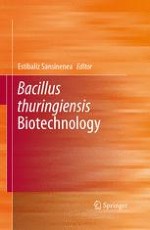2012 | OriginalPaper | Buchkapitel
6. Evolution of the Bacillus cereus Group
verfasst von : Dr. Ole Andreas Økstad, Dr. Anne-Brit Kolstø
Erschienen in: Bacillus thuringiensis Biotechnology
Verlag: Springer Netherlands
Aktivieren Sie unsere intelligente Suche, um passende Fachinhalte oder Patente zu finden.
Wählen Sie Textabschnitte aus um mit Künstlicher Intelligenz passenden Patente zu finden. powered by
Markieren Sie Textabschnitte, um KI-gestützt weitere passende Inhalte zu finden. powered by
